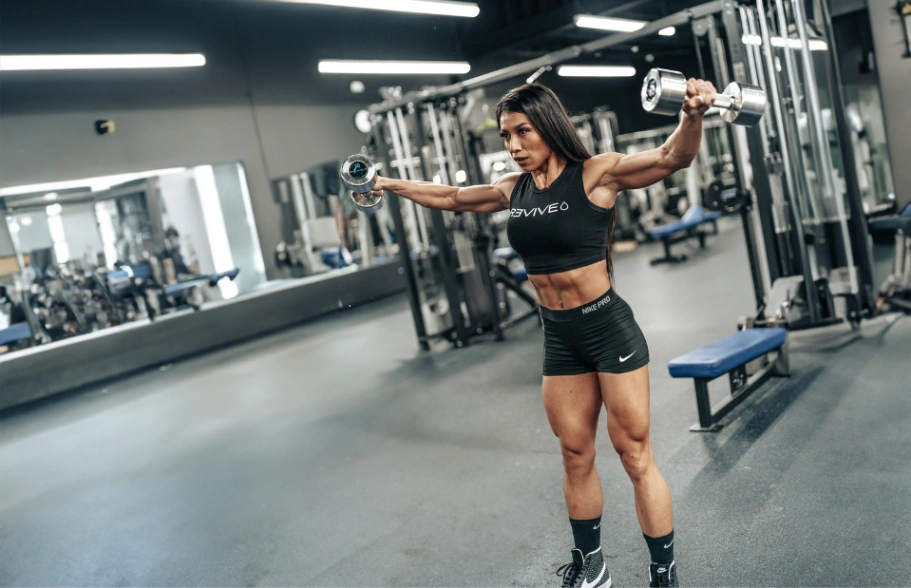Getting bored of your routine or maybe you feel like you’ve plateaued? If you're getting tired with the standard cardio and weightlifting sessions, why not add a bit of variety to your workouts? Adding different types of training can really amp up your strength and fitness, and keep things interesting. A good fitness plan doesn't just focus on one thing – it targets your whole body and all your physical skills. This approach not only ramps up your performance but also enhances your day-to-day life and lowers the chance of injuries. Eager to elevate your fitness game? Let's explore six training styles you should definitely give a go.

1. Functional Training: Exercises That Mimic Real Life Movements
Functional training is all about exercises that mimic daily tasks, like going up stairs or reaching for something high up on a shelf. These workouts engage your whole body, putting a focus on your core and balance, and they're great for boosting your coordination too.
Some simple functional exercises that mimic everyday movements:
- Squats: Mimics the motion of sitting and standing, a fundamental movement in daily life.
- Lunges: Simulates walking or running, focusing on leg and core strength.
- Deadlifts: Teaches proper lifting techniques, useful for picking up objects from the ground.
- Push-ups: Replicates pushing movements, useful in various real-life situations.
- Pull-ups or Rows: Improves upper body strength for any lifting or pulling actions.
- Step-Ups: Mimics climbing stairs, focusing on the legs and stability.
- Planks: Develops core strength, important for stability and everyday movements.
Functional training helps make everyday tasks easier and less tiring and by adding them to your regular gym routine, you'll become stronger and more capable in all areas of life.

2. Mobility Training: Improve Flexibility and Range of Motion
Mobility training helps increase your flexibility and range of motion. By improving joint mobility and muscle pliability, you'll move with greater ease and less risk of injury.
Stretching
Performing basic stretches 2-3 times a week can make a big difference. Hold each stretch for 15-30 seconds without bouncing.
Foam Rolling
Foam rolling, also known as self-myofascial release, helps loosen tight muscles and connective tissue. Roll up and down the length of your muscles using your own body weight. Focus on legs, glutes, back, and shoulders.
Yoga or Tai Chi
Yoga and tai chi are excellent for improving mobility and flexibility. They incorporate gentle movements, stretches, and postures to increase your range of motion.
With regular mobility training, you'll gain flexibility, move more freely, and feel more comfortable being active. Be gentle and go at your own pace.

3. Strength Training: Build Muscle and Increase Metabolism
Strength training is really important in any well-rounded workout plan. When you build muscle, it helps speed up your metabolism, meaning you'll burn more calories throughout the day. Try to include compound exercises in your routine that target several muscle groups at the same time.
Use free weights
Free weights like dumbbells and barbells allow for a greater range of motion than machines. They also engage more stabilizing muscles.
Go heavy
Use enough weight that you can only perform 6-8 reps per set with good form. This helps maximize muscle gain. Take longer rest periods between sets, around 2-3 minutes. Be sure to start lighter and build up the weight gradually to avoid injury.
Include bodyweight exercises
Exercises like pushups, pull-ups, lunges and burpees require no equipment but provide an intense strength challenge. Try doing a few sets with higher reps, around 10-15 per set. Bodyweight exercises can be done anywhere and help build functional strength.
If you want to build strength and get fitter, try mixing up your workouts with a combination of weightlifting, bodyweight exercises, and varying intensities. Remember, it's all about being consistent and taking things one step at a time, gradually increasing the difficulty. Combining strength training with other aspects of a well-rounded fitness routine is a great way to work towards your fitness goals.

4. Balance Training: Enhance Stability and Prevent Injury
Working on your balance is really important for improving stability and coordination, and it also helps in preventing injuries. As we get older, our balance tends to get a bit wobbly, but doing certain exercises can really help slow down that decline. Incorporating balance exercises into your regular workout routine can bring some great benefits.
Improve stability
Balance exercises strengthen your core and leg muscles, improving your stability and making daily activities easier. Simple moves like standing on one leg, heel-to-toe walking, and tai chi can boost your balance and stability.
Prevent falls
About one in three adults over 65 fall each year, often due to poor balance. Balance training reduces your risk of falls by strengthening your muscles and improving your coordination. Exercises that challenge your balance, like standing with one foot in front of the other, can help build strength and stability.
Enhance performance
Better balance and core strength translate to improved performance in fitness and sports. Balance training helps athletes have more control and precision in their movements. It also leads to greater power and efficiency.
Reduce injury risk
Strong balance and stability minimize stress on your joints and connective tissue, decreasing the likelihood of injuries like sprains, strains, and fractures. Balance exercises are particularly helpful for preventing ankle sprains and knee injuries.
Adding just 10-15 minutes of balance training 2-3 times a week can significantly boost your stability and coordination. Start with simple balance exercises like standing on one leg, heel-to-toe walking, and tai chi. As your balance improves, try more advanced moves like standing with one foot in front of the other. Balance training, when done consistently, leads to life-changing benefits for people of all ages and activity levels.

5. Stretching: Increase Flexibility
Stretching is essential for overall fitness and flexibility. When you stretch, you're increasing the range of motion in your joints and muscles, which makes daily activities easier and lowers the risk of injury. Stretching also releases tension and stress, providing both physical and mental benefits.
To get the most out of your stretching routine:
- Focus on major muscle groups. Target areas like your hamstrings, quadriceps, chest, back, and shoulders. Hip openers and glute stretches also provide a lot of benefit.
- Hold each stretch for 15-30 seconds. Find the point where you feel tension and hold. Breathe steadily and deeply as you stretch.
- Stretch when your muscles are warm. Stretching cold muscles can lead to injury. Do some light cardio first or stretch after a warm shower.
- Start slowly and build up. Don't bounce while stretching. Move into the stretch in a slow, controlled motion.
- Be consistent. Even stretching 2-3 times a week for 15 minutes a session can significantly improve your flexibility and range of motion over time.
- Try different stretching techniques. Static stretching, dynamic stretching, and yoga or Tai Chi are all effective. Rotate through the different types to keep things interesting.
- Listen to your body. Stretching should feel good. Stop if you feel pain. You can push into the stretch a bit, but it should never be painful.
Staying flexible and mobile is key to overall health and wellness. Establishing a regular stretching routine, along with strength and cardio training, will help you achieve total fitness and allow you to do all the physical activities you enjoy for years to come.

Agility Training: Improve Speed, Coordination and Reaction Time
Agility training improves your speed, coordination, and reaction time. This type of training involves exercises that require quick lateral movements, fast feet, and explosive changes in direction.
Here are some benefits on agility training:
- Improves Coordination and Balance: Agility training enhances your ability to control your body's movements efficiently, leading to better coordination and balance.
- Increases Reaction Time: This type of training helps in improving your reaction time, making you quicker in responding to various stimuli.
- Reduces Injury Risk: By improving balance, coordination, and body awareness, agility training can help in preventing injuries.
- Enhances Functional Movements: Agility training improves your ability to perform everyday activities with ease and efficiency.
- Boosts Sports Performance: For athletes, agility training is crucial as it enhances performance in sports that require quick changes in direction and speed.
- Improves Cognitive Function: This training also requires mental focus, which can boost cognitive functions like concentration and memory.
This type of training includes movements like ladder drills, cone drills, and plyometric exercises, all designed to get your body moving quickly and efficiently.
Including agility training 2-3 times a week will significantly enhance your speed, coordination, balance, and athletic performance over time. Even just 15-20 minutes of focused agility work can provide major benefits. Start at a level that challenges you but doesn't feel impossible, and build up your speed and complexity over weeks and months of regular training.
Cardio and Muscle Building in Your Fitness Routine
When aiming for total fitness, it’s common to wonder, can I do cardio and build muscle simultaneously? The answer is yes! By incorporating both into your training routine, you can optimize your overall fitness. Functional training, for example, allows you to build muscle through strength exercises while improving cardiovascular endurance through more dynamic movements.
The beauty of integrating cardio into your muscle-building routine is that it supports muscle growth in several ways. Cardio helps increase blood flow, which enhances muscle recovery and provides oxygen and nutrients to muscles during workouts. This helps to improve performance in both strength and endurance training, ensuring you’re getting the most out of your cardio and muscle-building efforts.
If you’re still wondering, can I do cardio and build muscle, the answer is simple: when done in a balanced way, both can coexist, leading to greater fitness and better results across the board. By incorporating these two aspects, you not only strengthen your body but also improve your stamina, endurance, and overall fitness level.
Conclusion
The six pillars of a balanced fitness routine that will get you into the best shape of your life. Mix and match these training types and you'll be strengthening your body and mind in no time. The benefits are huge - improved mobility, flexibility, balance, and power. Not to mention the mood boost and confidence that comes from feeling fit and healthy. What are you waiting for? Lace up those sneakers, get to the gym, and start reaping the rewards of functional mobility training, weights, balance exercises, agility drills, stretching, and everything in between. You've got the knowledge, now go out there and achieve total fitness!
Want to learn more about fitness, nutrition and overall health? Join us now at Team Dynasty!

